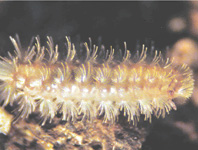Abstract
Two new penicillate millipede species from the genera Unixenus and Monographis (Diplopoda, Polyxenidae) were collected from Phu Quoc Island, Vietnam’s largest island. Unixenus intragramineus sp. n. was found within the stem of a creeping grass growing on an unstable, sandy substrate in the intertidal zone. The defining taxonomic characteristics of the genus Unixenus were apparent in U. intragramineus sp. n., but it is distinctively different from all described species. Monographis phuquocensis sp. n. belongs to a group of Monographis species which have their antennal sensilla arranged in a crescent-shape; but the structure of the labrum and telotarsus observed in this new species differs from other described Monographis.
References
Attems, C. (1907) Javanische Myriopoden, gesammelt von Direktor K. Kraepelin im Jahre 1903. Mitteilungen aus dem Naturhistorischen Museum in Hamburg, 24 (1906), 77–142.
Attems, C. (1938) Die von Dr. C. Dawydoff in französisch Indochina gesammelten Myriopoden. Mémoires du Muséum national d'histoire naturelle, Nouvelle Série, 6, 187–353.
Condé, B. & Jacquemin, M. (1962) Dipolopodes Pénicillates de Madagascar et des Mascareignes. Revue Française d’Entomologie, 29 (4), 254–285.
Condé, B. & Nguyen Duy-Jacquemin, M. (1963) Diplopodes Pénicillates récoltés à Bombay par P.A. Remy. Revue française d'Entomologie, 30, 68–78.
Condé, B. & Terver, D. (1963) Pénicillates de Côte d’Ivoire (récoltes de M. Vuillaume). Bulletin Scientifique de l’Institut Fondamental d’Afrique Noire, 25 (A), 669–684.
Condé, B. & Nguyen Duy-Jacquemin, M. (1984) Diplopodes pénicillates de Papouasie et de Borneo. Revue Suisse de Zoologie, 91 (1), 47–55.
https://doi.org/10.5962/bhl.part.81868Condé, B. & Nguyen Duy-Jacquemin, M. (1992) Découverte d’un caractѐre sexuel secondaire nouveau chez le mâle d’un Polyxénidé (Myriapodes, Pénicillates). Berichte des naturwissenschaftlichen-medizinischen Verein Innsbruck, Supplementum 10, 57–62.
Condé, B. & Nguyen Duy-Jacquemin, M. (2008) Classification actuelle des Diplopodes Pénicillates (Myriapodes) avec nouvelles définition des taxa. Bulletin de la Société Zoologique de France, 133, 4, 291–302.
GenBank website (2018) National Center for Biotechnology Inofrmation. Available from: http://www.ncbi.nlm.nih.gov (accessed 31 October 2017)
Golovatch, S. I. & Martens, J. (2018) Distribution, Diversity Patterns and Faunogenesis of the Millipedes (Diplopoda) of the Himalayas. ZooKeys, 741, 3–34.
Huynh, C. & Veenstra, A. (2013) Taxonomy and biology of a new species of Pincushion Millipede of the genus Monographis (Diplopoda: Polyxenida) from Australia. Zootaxa, 3721 (6), 573–588.
https://doi.org/10.11646/zootaxa.3721.6.4Huynh, C. & Veenstra, A. (2015) Description of a new species of Penicillate Millipede from the genus Monographis (Diplopoda: Polyxenidae) found in Vietnam. Zootaxa, 3964 (4), 460–474.
https://doi.org/10.11646/zootaxa.3964.4.5Ishii, K. & Yin, W.-Y. (2000) New species of Penicilata (Diplopoda) from Yunnan, Southwest China. In: Aoki, J., Yin, W.Y. & Imadate, G. (Eds.), Taxonomical studies on the soil fauna of Yunnan Province in Southwest China. Tokai University Press, Tokyo, pp. 91–116.
Jones, S. (1937) On two new south Indian pselaphognathous diplopods. Zoologischer Anzeiger, 119, 138–146.
Jones, S. (1944) Mechanism of defence in a Pselaphognathous Diplopod, Unixenus padamanbhii Jones. Proceedings of the Indian Science Congress, 31 (3), 94 – 95.
Luan, Y.X., Mallatt, J.M., Xie, R.D., Yang, Y.M. & Yin, W.Y. (2005) The phylogenetic positions of three basal-hexapod groups (Protura, Diplura, and Collembola) based on ribosomal RNA gene sequences. Molecular Biology and Evolution, 22, 1579–1592.
https://doi.org/10.1093/molbev/msi148Manton, S.M. (1956) The Evolution of Arthropodan Locomotory Mechanisms—Part 5. The Structure, Habits and Evolution of the Pselaphognatha (Diplopoda). Journal of the Linnean Society London, 43, 153–187.
https://doi.org/10.1111/j.1096-3642.1957.tb02516.xMeyer, C.P. (2003) Molecular systematics of cowries (Gastropoda: Cypraeidae) and diversification patterns in the tropics. Biological Journal of the Linnean Society, 79, 401– 459.
https://doi.org/10.1046/j.1095-8312.2003.00197.xNguyen Duy-Jacquemin, M. & Condé, B. (1966) Pénicillates nidicoles de Malaisie. Revue d’Ecologie et de Biologie du Sol, 3, 621–624.
Nguyen Duy-Jacquemin, M. & Condé, B. (1967) Morphologie et géonémie du genre Monographis. Mitteilungen aus dem Hamburgischen Zoologischen Museum und Institut, 64, 43–81.
Short, M. & Huynh, C. (2010) A technique for examination of disagnostic characters of penicillate millipedes. Memoirs of Queensland Museum, Nature, 55 (1), 231–234.
Short, M. & Huynh, C. (2011) The genus Unixenus Jones, 1944 (Diplopoda, Penicillata, Polyxenida) in Australia. Zookeys, 156, 105–122.
https://doi.org/10.3897/zookeys.156.2168Short, M. & Huynh, C. (2013) Four new species of Unixenus Jones, 1944 (Diplopoda, Penicillata, Polyxenida) from Australia. ZooKeys, 278, 75–90.
https://doi.org/10.3897/zookeys.278.4765Silvestri, F. (1948) Tavola sinottica dei generi dei Diplopoda Penicillata. Bollettino del Laboratorio di Entomologia Agraria, Portici, 8, 214–220.
Turbeville, J.M., Pfeifer, D.M., Field, K.G. & Raff, R.A. (1991) The phylogenetic status of arthropods, as inferred from 18S rRNA sequences. Molecular Biology and Evolution, 8, 669–686.
Turk, F.A. (1947) On a collection of Diplopods from north India, both Cavernicolous and Epigaean. Proceeding of the Zoological Society of London, 117, 65–78.
https://doi.org/10.1111/j.1096-3642.1947.tb00498.xVerhoeff, K.W. (1924) Results of Dr. E. Mjöbergi’s Swedish Scientific Expeditions to Australia 1910–1913. Vol. 34. Myriapoda: Diplopoda. Arkiv för Zoologi, 16 (5), 1–142.
Wesener, T., Raupach, M.J. & Sierwald, P. (2010) The origins of the giant pill-millipedes from Madagascar (Diplopoda: Sphaerotheriida: Arthrosphaeridae). Molecular Phylogenetics and Evolution, 57, 1184–1193.
https://doi.org/10.1016/j.ympev.2010.08.023Wesener, T., Voigtländer, K., Decker, P., Oeyen, J.P. & Spelda, J. (2016) Barcoding of Central European Cryptops centipedes reveals large interspecific distances with ghost lineages and new species records from Germany and Austria (Chilopoda, Scolopendromorpha). ZooKeys, 564, 21–46.
https://doi.org/10.3897/zookeys.564.7535White, T.J., Bruns, T., Lee, S. & Taylor, J.W. (1990) Amplification and direct sequencing of fungal ribosomal RNA genes for phylogenetics. In: Innis, M.A., Gelfand, D.H., Sninsky, J.J. & White, T.J. (Eds.), PCR Protocols: A Guide to Methods and Applications. Academic Press, Inc., New York, pp. 315–322.
https://doi.org/10.1016/B978-0-12-372180-8.50042-1

